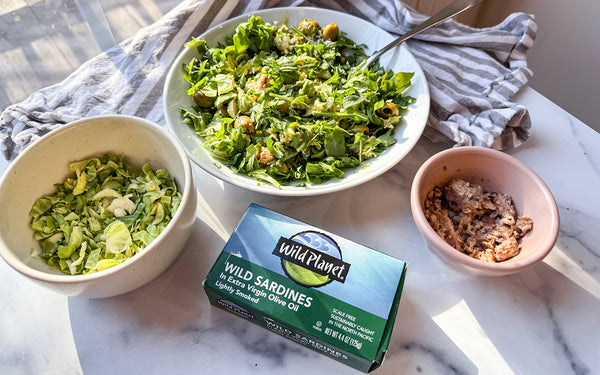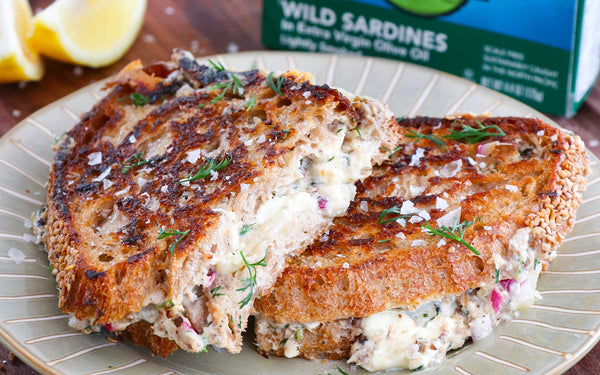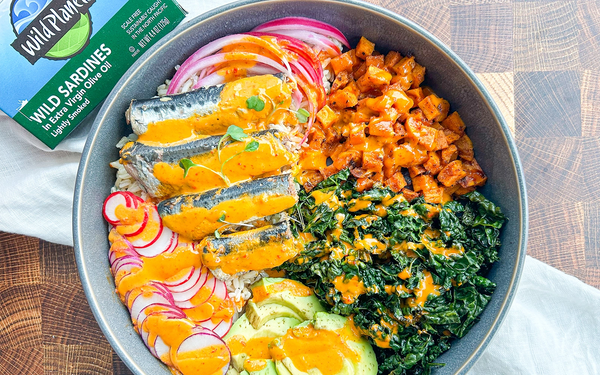 Ever wondered how fish actually compares to other animal proteins? It is important to understand the health benefits of fish and how to make sure you are getting the best protein for you and your family. We invited blogger Michael Kummer to give his input on why he prefers fish as his protein and why he chooses Wild Planet over other options.
Ever wondered how fish actually compares to other animal proteins? It is important to understand the health benefits of fish and how to make sure you are getting the best protein for you and your family. We invited blogger Michael Kummer to give his input on why he prefers fish as his protein and why he chooses Wild Planet over other options.
I grew up in Austria during the 1980s and early 90s, and my family followed a typical Central European diet. It consisted of bread at almost every meal, starchy vegetables like potatoes as a staple side dish, and an almost unimaginable amount of processed meat — everything from nitrate-rich cured meats like ham, to cold cuts, to sausages of every shape, size and color.
My grandpa was an avid fisherman. So, we also had access to fresh rainbow trout he caught in the lakes around my hometown of Salzburg. But, when I think about my fish consumption as a child, what I remember most is the frozen, breaded fish sticks I ate on a regular basis.
Knowing what I know now about how those foods wreak havoc on the human body — from disturbing the gut microbiota to spurring the inflammation at the root of so many modern health ailments — it’s no wonder that my father suffered from lifelong stomach problems.
During my childhood, I developed into a successful track and field athlete, eventually going on to compete as a professional 100-meter sprinter. I was in my early 20s and in outstanding overall physical condition — strong, lean and fast. Despite my athletic ambitions, I paid no attention to my diet and, as a result, I struggled with the same kinds of stomach problems as my dad. It wasn’t until years later, after diving deep into the science of nutrition and adopting a Paleolithic lifestyle, that I realized how strongly the foods we eat are linked to how we feel.
Today, I feel better than ever. I’m an avid CrossFitter, an advocate for healthy lifestyles on my blog, and my stomach problems are a thing of the past. I’d like to share a little bit about why fish is such a key part of my ketogenic paleo diet, as well as a few important things you need to consider if you’re planning on adding more fish to your table.
Why Fish Is My Top Choice For Animal Protein
As someone with a history of gastrointestinal problems, one of the things I love most about fish is how easy it is to digest compared to other animal proteins. This is due largely to its relative lack of connective tissue (such as collagen), which is also what makes its flesh so soft, tender and flaky.
But, fish is also a veritable treasure trove of nutrients. The exact nutritional contents vary by species, but in general, it has high concentrations of B2 (riboflavin), calcium, iodine, iron, magnesium, phosphorus, potassium and zinc. Varieties like salmon, tuna, mackerel, and sardines are loaded with Omega 3 fatty acids, which support heart health, brain function, vision and a whole host of other biological processes.
Fish is also one of nature’s richest sources of vitamin D, which is especially beneficial for paleo dieters and others who avoid dairy. Vitamin D assists the body with the absorption of calcium, and getting enough of it is important for making efficient use of the calcium you obtain through foods like kale and broccoli.
And speaking of calcium, fish bones — like those found in Wild Planet’s sardines — are a fantastic source of it. Many people are in the habit of removing the bones before consumption, but there’s no need to; they’re healthy and perfectly edible.
Not All Fish Has The Same Nutritional Profile
While the health benefits of eating fish are numerous, there are also a few things you need to be aware of when choosing the types of seafood that make it onto your plate and into your gut.
In the wild, salmon eat a diverse diet that includes plankton, algae, small fish and other small invertebrates, which broadens their nutritional profile. But, salmon from aquaculture have a much more monolithic diet comprised largely of fish by-product, as well as corn and soy (two cheap food sources that help fatten them up).
Toxic chemicals
Additionally, most farmed Atlantic salmon is contaminated with toxic chemicals — including ethoxyquin (EQ), butylated hydroxytoluene (BHT) and butylated hydroxyanisole (BHA) — which are used as preservatives in industrial-scale fish food. While manufacturers and the aquaculture industry claim these chemicals pose no harm to humans at low levels of consumption, there’s limited long-term research on the topic.
Farmed salmon has also been found to contain significantly higher concentrations of polychlorinated biphenyls (PCBs), a class of industrial chemicals banned from production in 1979. Unfortunately, PCBs — which have been shown to have negative health effects relating to the immune, nervous and endocrine systems — persist in the environment and are absorbed by aquatic life (and by fish in particular). Since salmon from aquaculture are fed large amounts of fish by-product, they have increased exposure to these chemicals.
Heavy metals
Many people believe they should avoid fish altogether because of heavy metals, and because of mercury in particular, which is toxic and can have serious health consequences if too much of it is in your system. Like PCBs, fish absorb mercury over the course of their life — largely as a result of water pollution. While it’s true that almost all fish contain at least trace levels of mercury, research shows that these levels are usually so low that they pose little or no health risk. However, some species of fish live longer and grow larger than others, and therefore contain relatively high amounts of mercury. Fish like these should only be consumed in moderation.
Here’s a list showing the average mercury content of a few species of commonly-consumed fish, according to the U.S. Food and Drug Administration:
-
Swordfish: 0.995 ppm
-
Shark: 0.979 ppm
-
Cod: 0.111 ppm
-
Trout: 0.071 ppm
-
Salmon: 0.022 ppm
-
Anchovies: 0.017 ppm
-
Sardines: 0.013 ppm
Why I Choose Wild, Sustainably-Caught Fish
My family and I eat exclusively wild-caught fish. From a health perspective, it’s a no-brainer. As a father, I can’t in good conscience feed my children an inferior product that I know is contaminated with toxic chemicals and substances. I care deeply about my children’s health and feel that I have an ethical responsibility to use all the tools, knowledge and resources at my disposal to make the best possible nutrition choices on their behalf.
When it comes to animal products, I look for options that are as close to natural as possible. That means I choose eggs from chickens that roam around pastures eating bugs, and I choose fish that spent their lives swimming around being fish... not stuffed into a cramped underwater pen.
In the same vein, I feel an ethical responsibility to do what I can to make sure the world they inherit is clean and vibrant, and that they can enjoy the same diversity of foods and resources we enjoy today. While industrial aquaculture has its own set of negative environmental impacts, irresponsible harvesting of wild fish has the ability to decimate fish stocks and upend entire ecosystems.
One of the reasons I choose Wild Planet products is because of the company’s commitment to sustainable fishing practices. As part of its “Wild Way” promise, Wild Planet ensures that their fishing doesn’t impact the biomass or habitat of the species. You can watch more about their sustainability practices here:
The Healthiest – and Least Healthy – Ways to Eat Fish
My favorite way to prepare salmon (my go-to fish) is by curing it with lime juice. While baked fish is perfectly healthy, the cooking process can damage some of the heat-sensitive nutrients, such as the Omega 3 fatty acids. Wild Planet only cooks their fish once so it retains a lot of the nutrients.
Other methods, such as steaming, broiling, and grilling are also fine. But from a paleo perspective, be aware that poached fish is often (though not always) made using either butter or milk.
Perhaps the least healthy way to eat fish is fried; while those fish sticks I ate so many of as a kid back in Austria sure tasted good, they were nothing but over-processed junk food — about as far removed from “fish” as fast-food hamburgers are from grass-fed, pasture-raised beef.
Unfortunately, fried fish tends to be the easiest and cheapest option available. As someone who travels regularly for work, I don’t always have access to healthy seafood. Even when I’m at home, life gets busy and it’s not always possible for my wife and me to take the time to cook the way we’d like to.
That’s why I love Wild Planet’s canned fish. It’s a brand that I know is committed to the same health and environmental values that matter to me. I trust Wild Planet, and when life gets hectic, I rely on their products to provide a high-quality, great-tasting source of protein that helps me and my family keep living healthy.
Thanks to Michael, we've got a fresh perspective on the health benefits of fish and what to look out for when purchasing seafood. Share with us your thoughts on why you choose to eat fish for a healthy protein!
The views and opinions expressed in this post are solely those of the author and are not necessarily a reflection of the opinions and views of Wild Planet Foods. The content provided (and any linked or referenced materials) should not be construed as medical advice. Should you have any health or nutrition-related questions, please consult a doctor or healthcare practitioner.
The author received products from Wild Planet for editorial purposes only. The opinions and recommendations are solely those of the author and were not influenced by Wild Planet Foods in any way.










